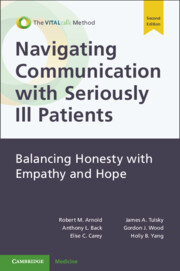Book contents
- Navigating Communication with Seriously Ill Patients
- Navigating Communication with Seriously Ill Patients
- Copyright page
- Dedication
- Reviews
- Contents
- Preface
- Acknowledgments
- 1 Taking Your Skills to the Next Level
- 2 Foundational Communication Skills
- 3 Talking about Serious News
- 4 Discussing Prognosis
- 5 Planning for the Future: Discussing What’s Important, Well Before a Crisis
- 6 Discussing Treatment Decisions
- 7 Between the Big Events
- 8 Goals of Care in Late-Stage Disease
- 9 Conducting a Family Conference
- 10 Dealing with Conflicts between Clinicians and Patients
- 11 Working Through Conflicts with Colleagues
- 12 When You’re Really Stuck
- 13 Talking about Dying
- 14 Cultivating Your Skills
- Index
- References
2 - Foundational Communication Skills
Published online by Cambridge University Press: 05 April 2024
- Navigating Communication with Seriously Ill Patients
- Navigating Communication with Seriously Ill Patients
- Copyright page
- Dedication
- Reviews
- Contents
- Preface
- Acknowledgments
- 1 Taking Your Skills to the Next Level
- 2 Foundational Communication Skills
- 3 Talking about Serious News
- 4 Discussing Prognosis
- 5 Planning for the Future: Discussing What’s Important, Well Before a Crisis
- 6 Discussing Treatment Decisions
- 7 Between the Big Events
- 8 Goals of Care in Late-Stage Disease
- 9 Conducting a Family Conference
- 10 Dealing with Conflicts between Clinicians and Patients
- 11 Working Through Conflicts with Colleagues
- 12 When You’re Really Stuck
- 13 Talking about Dying
- 14 Cultivating Your Skills
- Index
- References
Summary
Four core communication skills are “Ask-tell-ask”, recognize and respond to emotion, ask permission to move forward, and “Tell me more…” “Ask-tell-ask” is asking what the patient or surrogate knows about the medical situation, telling them the headline (information and meaning), and asking what they are taking away from your conversation. Recognizing and responding to emotion, both verbal and nonverbal, can allow patients to discuss additional medical information, builds connection between clinician and patient, and can clarify what is important to the patient. Responding to emotion may be nonverbal or verbal (e.g., NURSE statements), and may include simple or complex reflections or “wish statements”. Asking permission to move the conversation forward signposts that there is a transition, allows patients control, and helps you judge if they are ready. Finally, “Tell me more…” helps clarify informational needs or allow a deeper view into a patient’s reasoning or emotional space, giving the clinician guidance on where to direct the conversation. In telemedicine, communication skills need to be adapted as some of the in-person nonverbal skills are less effective or impossible.
- Type
- Chapter
- Information
- Navigating Communication with Seriously Ill PatientsBalancing Honesty with Empathy and Hope, pp. 15 - 35Publisher: Cambridge University PressPrint publication year: 2024

